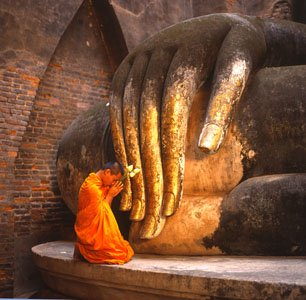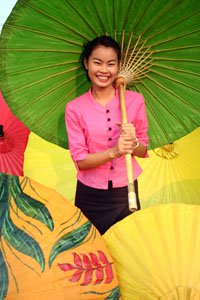Royal Siam
At once mysterious and welcoming, Thailand is a tropical paradise with hidden depths beyond its beaches, spa resorts and nightlife.
 Typically South East Asian, Thailand is the confluence of three great cultures. Dominated for centuries by the neighbouring Khmer, the people of Thailand have also been strongly influenced by India and China. From early Hindu influences through to Buddhist conversion, the Thai have borrowed from their Indian and Chinese neighbours to create a distinctive identity of their own. While many of these traditions may have their origins in the India of classical times, and while a large percentage of the population is of Chinese extraction, the resulting mix is a spicy blend that can be rightly labelled as Thai.
Typically South East Asian, Thailand is the confluence of three great cultures. Dominated for centuries by the neighbouring Khmer, the people of Thailand have also been strongly influenced by India and China. From early Hindu influences through to Buddhist conversion, the Thai have borrowed from their Indian and Chinese neighbours to create a distinctive identity of their own. While many of these traditions may have their origins in the India of classical times, and while a large percentage of the population is of Chinese extraction, the resulting mix is a spicy blend that can be rightly labelled as Thai.
The Thai, or Siamese, state was established when the country broke free from the yoke of its Khmer masters and established the first of several dynasties, the Sukhothai, in the 13th century. From then on, the nation became a major power in the region, eventually even wreaking its revenge on the Khmer as the 15th century Kingdom of Ayutthaya invaded modern-day Cambodia and destroyed the old Khmer capital at Angkor. Smaller kingdoms competed for power until the nation was finally unified in the late 18th century and bordering areas incorporated under King Rama I, founder of the Chakri dynasty that rules to this day.
The Chakri kings have served Thailand well, for through their cunning they managed to play the French and British off against one another and become one of the few countries not to have been colonised by a European power. By 1932, however, a bloodless uprising forced the ruling king to abolish absolute rule in favour of a constitutional monarchy, and though the nation has been through decades of political turmoil and military coups, it has always officially remained a democratic kingdom. The rapid economic development that made Thailand one of the Asian Tigers of the 1980s and 1990s has helped to bring prosperity and until recently political stability.
A modern tiger
A very important part in the transition from an archaic Asian kingdom into a modern ‘Tiger’ has been played by tourism. The fact that Thailand is now an up and coming economy and a regional player can be thanked in part to all those bodies bronzing on its tropical beaches, though also to the concerted efforts made to modernise, industrialise and become a commercial centre in its own right. The transition that began with cheap manufacture and the influx of foreign tourists has since turned especially Bangkok into a modern metropolis where the bright lights, traffic jams and ultramodern high-rise and shopping malls of the 21st century coexist with large remnants of poverty and antiquity.
The imposing Grand Palace, official residence of King Bhumibol Adulyadej, along with the many beautiful Buddhist temples and shrines, represent the gilded antiquity and rich cultural heritage of a proud nation. The longest-serving head of state in the world, the monarch, who has reigned since 1946, forms a direct link with the Royal Siam of old, a link that is further enhanced by the Buddhist faith – but one that is also threatened by the encroachment of the modern world. In Bangkok, as in many Thai cities, the desire to preserve the past while ambitiously embracing the future is an all-consuming drive that often neglects to remember the plight of the country’s poor.
 So along towering office blocks and carefully preserved temples you will also find the Thailand of old, where poverty and tradition still colour the markets, street scenes and daily lives of millions with the ways of the past. This is the Thailand that all but a handful of tourists and businessmen avoid, and the one that has become forgotten when the country became variously associated with luxurious beach resorts, sordid sex tourism, economic boom and lofty cultural displays. That this mix of parallel worlds can be an explosive one was seen in the developments of recent years, when political unrest returned to the streets of Thailand, though it does little to change our perception of the Friendly Tiger of Asia.
So along towering office blocks and carefully preserved temples you will also find the Thailand of old, where poverty and tradition still colour the markets, street scenes and daily lives of millions with the ways of the past. This is the Thailand that all but a handful of tourists and businessmen avoid, and the one that has become forgotten when the country became variously associated with luxurious beach resorts, sordid sex tourism, economic boom and lofty cultural displays. That this mix of parallel worlds can be an explosive one was seen in the developments of recent years, when political unrest returned to the streets of Thailand, though it does little to change our perception of the Friendly Tiger of Asia.
Hidden layers
To the visitor, Thailand is therefore whichever layer he or she wishes to lift. Seek the embodiment of tropical paradise along Thailand’s southern shores, where tourists flock to resort towns or sumptuous spa resorts. Alternatively you may want to be seduced by the heady atmosphere of fast-moving Bangkok, where economic growth and new money breed the confidence that shapes a modern world of shopping, nightlife and refinement in tomorrow’s futuristic temples. Earnest explorers will want to marvel at the temples of the past, follow the locals into shady streets and noisy markets, and into the beautiful countryside to discover the still largely authentic charms of rural Thailand as they ride elephants or gaze over perfect green rice fields.
The real Thailand lies in all these places: from the strippers of neon-lit streets to the coy Thai dancers and reverential palaces and temples of another age, the opulence of designer resorts and nightclubs to the earthy atmosphere of urban and rural life. Thailand is modern and tradition, hardworking and hedonistic, rich and poor. Above all it is fascinating, and accepting, so take from the experience what you dare, or prefer, and old Siam will reward you in kind.












